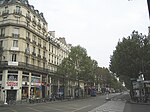Étienne Marcel (Paris Métro)
AC with 0 elementsParis Métro line 4Paris Métro stations in the 1st arrondissement of ParisParis Métro stations in the 2nd arrondissement of ParisRailway stations in France opened in 1908

Étienne Marcel (French pronunciation: [etjɛn maʁsɛl]) is a station on Line 4 of the Paris Métro. It is located in the northeastern part of the 1st arrondissement.
Excerpt from the Wikipedia article Étienne Marcel (Paris Métro) (License: CC BY-SA 3.0, Authors, Images).Étienne Marcel (Paris Métro)
Rue de Turbigo, Paris 2nd Arrondissement (Paris)
Geographical coordinates (GPS) Address Nearby Places Show on map
Geographical coordinates (GPS)
| Latitude | Longitude |
|---|---|
| N 48.864166666667 ° | E 2.3505555555556 ° |
Address
Pharmacie Nahon
Rue de Turbigo
75002 Paris, 2nd Arrondissement (Paris)
Ile-de-France, France
Open on Google Maps









